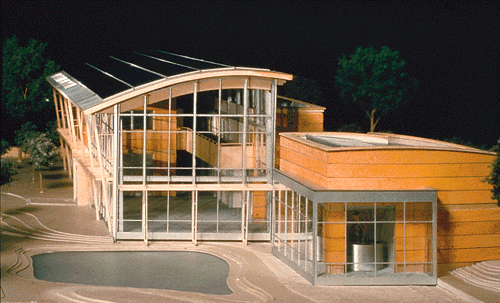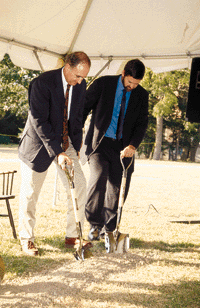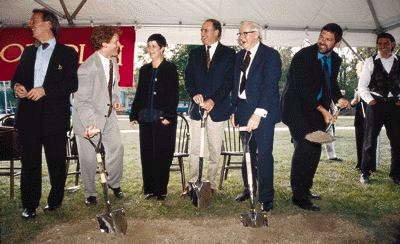Breaking New Ground
By Marci Janas '91
Nationally-known expert and professor of environmental studies David Orr has accomplished a great many things, not the least of which is the vision-soon-to-be-reality known as the Adam Joseph Lewis Center for Environmental Studies. It is doubtful, however, that Orr can claim credit for the earthquake-5.2 on the Richter scale-that jostled Ohio and a few other states slightly more than one hour before the Center's groundbreaking ceremonies on the afternoon of September 25.
Nice bit of symbolism, though.
On ground south of Harkness House in the late fall of 1999, the Adam Joseph Lewis Center for Environmental Studies will stand as the most advanced example of ecological architecture in America. Steven Litt, architecture critic for the Plain Dealer, says that the Center "could be one of the most revolutionary structures of this century, or the next. It's not so much a building as it is a manifesto in bricks and mortar."
Click image to see larger illustrations |
 Click image to see ESC models |
President Nancy Dye calls the Center "the newest and quite possibly the most ambitious building project in Oberlin's 165-year historyŠa testament to the College's mission of educating students to make the world a better place."
Building, manifesto, or testament, the Lewis Center will provide Oberlin with the best possible laboratory for environmental education today, placing the College, once again, at the vanguard of positive change.
 "Many Oberlin students have already been involved in the planning and design of this building, and many more will be involved in future generations, modifying the technologies and design strategies they find here," says Dye. "All of them have and will take pride in the work of creating an ever lighter human footprint on the earth."
"Many Oberlin students have already been involved in the planning and design of this building, and many more will be involved in future generations, modifying the technologies and design strategies they find here," says Dye. "All of them have and will take pride in the work of creating an ever lighter human footprint on the earth."
Writing in The New York Times, Jay Parini endowed Orr, chair of the Environmental Studies Program, with the apt appellation "environmental guru." Orr led more than 250 students, faculty, and town residents in discussions with national ecological designers during the building's initial design phase three years ago. He also raised most of the funds for the project.
"We intended to create not just a place for classes but rather a building that would help redefine the relationship between humankind and the environment-one that would expand our sense of ecological possibilities," Orr says.
As ideas took shape team members pondered three questions: Is it possible-even in Ohio-to power buildings by current sunlight? Is it possible to create buildings that purify their own wastewater? Is it possible to build without compromising human and environmental health somewhere else or at some later time?
"In other words," Orr continues, "is it possible to design buildings so well and so carefully that they do not cast a long ecological shadow over the future that our students will inherit? We now know that such things are possible-that buildings can be designed to give more than they take."
For Oberlin, that knowledge will result in a 14,000-square-foot, $6.6 million, self-sustaining structure of classrooms, laboratories, and surrounding gardens. More than a building where teaching takes place, the Lewis Center will be a place that teaches. By virtue of the building's design concepts, students will learn ecological competence and mindfulness of place. They will learn competence with environmental technologies; analytical skills in assessing full costs over the building's lifetime; and how nature's principle that "waste equals food" can be successfully adapted for manufacturing processes and building materials.
There exists no precedent for a building such as this-one that will produce its own energy and treat wastewater for reuse through a Living Machine, replicating the natural purification processes of ponds and marshes. Nontoxic materials such as brick, wheat straw, and wood purchased from certified forests meeting environmental standards will be used throughout the building. Worn carpeting will be sent back to its manufacturer for disassembly and reuse. When completed, the Lewis Center will provide a focus of study for students in ecological engineering, architecture, city and regional planning, and more.

The project's head architect is William McDonough, who in 1996 won the first Presidential Award for Sustainable Development, the nation's highest environmental honor. Named by Time as "one of the most visionary of the green designers," McDonough is founding principal of William McDonough & Partners Architects and Planners. He also serves as dean of the University of Virginia School of Architecture.
"Imagine a building that makes more energy than it needs to operate," McDonough says, "and then imagine the design assignment. Can you design a building that makes oxygen, sequesters carbon, fixes nitrogen, proves that solar energy is fuel, creates complex sugars and food, distills water, changes with the seasons, provides a habitat for hundreds of species? How many buildings do you know of that have produced oxygen lately?"
Data from a recent computer simulation indicates that the Lewis Center will use 21 percent of the energy of a typical new aca-demic building in this region, lowering its energy budget to less than one-quarter of the national average. The facility's energy use will be monitored and publicly displayed in the central atrium area.
Adam Joseph Lewis, for whom the building is named, was inspired by Orr's vision and direction and Oberlin's dedication to the project. He has provided leadership support by contributing the initial $1 million for the building with additional support from the Lewis family, bringing the total family commitment to $3.25 million.
"For many years I have searched for examples of where one can give as much to his environment as one takes," says Lewis, of Cleveland. "This Center is a paragon of environmental design. Each part and process of the building gives and takes. I am so pleased to support the Center and more pleased that we will all continue to learn from it."
Guiding the project from its inception through construction have been such leaders in the fields of ecology, education, and architecture as Amory Lovins and Bill Browning from the Rocky Mountain Institute; scientists from the NASA Lewis Space Center; John Todd and Michael Shaw, leading figures in the field of ecological engineering; the late landscape architect John Lyle; the firm of Andropogon, Inc.; and structural, electrical, and mechanical engineers Lev Zetlin, Inc. Lyle-the principal designer of the plaza outside the main entrance of the Center-died of cancer in July. The plaza will be named for him, in his honor. Lyle's daughter Cybele is a 1995 graduate of Oberlin.
MARCI JANAS is a poet and a staff writer in the Office of College Relations at Oberlin College.
